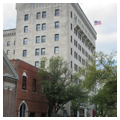Hailed as the tallest building in south central Arkansas at its completion, the eight-story building constructed for Lion Oil Corporation indicated El Dorado’s sudden rise to prominence in 1921 as the oil capital of Arkansas. Although the city’s economic base has broadened, the building retains its tallest-in-the-region status. Colonel T. H. Barton, a founder of Union Bank and president of Lion Oil Corporation, receives the major credit for the construction of the building that originally housed Union Bank on the ground level and the corporate headquarters of Lion Oil on the next four stories. Two stories were occupied by Murphy Oil Corporation, and the remaining area was rental office space. The steel-framed limestone-clad structure is a typical early skyscraper with an eclectic application of historical detail and L-shaped massing to provide light and ventilation to all the offices. At the base, large arched windows outlined with pronounced voussoirs illuminate the banking rooms and frame the entrances. Six floors of office spaces with paired plain windows are surmounted by a topmost story featuring arched windows outlined with polychrome tile and decorative balconies. This ornamentation along with a deep parapet fringed with pointed arches containing polychrome shields adds a Venetian Gothic flavor. The two-story gray marble-sheathed elevator lobby, lit by a brass Moorish-styled chandelier, includes a glass mail chute to the ornate and gilded eagle-topped mailbox that is still impressive. A 1960s modernization of the banking facilities, however, obliterated the original gloriously ornate beamed, tiled, and stenciled bank lobby. Fortunately, in Eugene J. Stern’s 1929 Albert Pike Hotel (PU27) in Little Rock a similar exotic lobby does exist and has been restored. George Mann and Stern were adept at providing corporate clients with modern tall buildings adorned with eclectic historic details, as in their Arlington Hotel (GA10) in Hot Springs.
You are here
First Financial Bank Building (Lion Oil Building, Exchange Bank)
If SAH Archipedia has been useful to you, please consider supporting it.
SAH Archipedia tells the story of the United States through its buildings, landscapes, and cities. This freely available resource empowers the public with authoritative knowledge that deepens their understanding and appreciation of the built environment. But the Society of Architectural Historians, which created SAH Archipedia with University of Virginia Press, needs your support to maintain the high-caliber research, writing, photography, cartography, editing, design, and programming that make SAH Archipedia a trusted online resource available to all who value the history of place, heritage tourism, and learning.




















